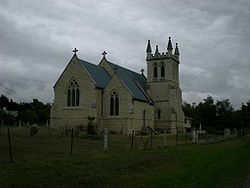- Duntroon, New Zealand
-
Duntroon (from Scottish Gaelic: Dùn Treòin) is a small farming town in the Waitaki District of New Zealand's South Island. Although traditionally considered a North Otago town, it is presently officially located within the farthest southern reaches of Canterbury. Just north of the town is the Waitaki River that forms the traditional border between the two regions, although the official border has now been moved south to put most of Waitaki District within Canterbury, including Duntroon. To the east of the village is the Maerewhenua River. Near the village are the Earthquakes, a limestone cliff formation.
St. Martin's Anglican Church, Duntroon
The 2001 census recorded Duntroon as having a population of 120, consisting of 69 females and 51 males, an increase of 3 people or 2.6% since the 1996 census. By the 2006 census the population had declined to 114. The town was named by Scottish settler and farmer Robert Campbell. Economic activity has been mainly agricultural for much of the town's history, focusing primarily on sheep farming and the growth of crops such as wheat and barley.
Duntroon is home to the Vanished World Heritage Centre, dedicated to showcasing the geology of the Waitaki region and preserving fossils of extinct species that have been found in the region. These include two species of the penguin genus Archaeospheniscus, Lowe's penguin and Lopdell's penguin. The town is also located near two sites of centuries-old Māori rock drawings.
Transport
Duntroon was once the terminus of the branch line railway that ultimately became the Kurow Branch, and was one of the few towns to be served by a railway station for the entire life of the line (most others were closed earlier than the line itself). In 1875, the railway from the junction with the Main South Line at Pukeuri was opened to Duntroon, but due to bridging difficulties, the line actually terminated outside Duntroon on the east side of the Maerewhenua River. In 1878, construction began on another line from Duntroon to Kurow; on 2 July 1881, the Maerewhenua River was finally bridged and Duntroon proper was linked to the national railway network; on 7 November 1881, the line beyond Duntroon opened and the town lost its status as terminus. The railway served the town for over a century, closing in mid-1983, and the old railway station now serves as a community crafts centre. Near the station building, an old water tank for steam locomotives still stands in good condition.
Duntroon will be on the route of the Alps to Ocean Cycle Trail, to be constructed in the following years after approval in 2010.
External links
- 2001 census data for Duntroon
- Vanished World Centre website
- Visitor's Guide to the Beautiful Waitaki - Duntroon
Coordinates: 44°52′S 170°41′E / 44.867°S 170.683°E
Towns of the Waitaki District, Canterbury/Otago, New Zealand Major towns Minor towns Localities Airedale • All Day Bay • Ardgowan • Awamoko • Billys Flat • Black Point • Bortons • Clearburn • Cormacks • Corriedale • Danseys Pass • Earthquakes • Elderslie • Enfield • Five Forks • Flag Swamp • Fuchsia Creek • Georgetown • Glenpark • Goodwood • Green Valley • Hillgrove • Hilderthorpe • Incholme • Inch Valley • Island Cliff • Island Stream • Kaika • Katiki • Kauru Hill • Kia Ora • Kokoamo • Kuriheka • Lake Aviemore • Lake Benmore • Lake Ohau • Lake Waitaki • Lindis Pass • Livingstone • Maerewhenua • Makareao • Maraeweka • Marakerake • Maruakoa • Meadowbank • Moonlight Flat • Morrisons • Nenthorn • Otekaieke • Otepopo • Otiake • Papakaio • Peebles • Pleasant Valley • Pukeraro • Puketapu • Queens Flat • Richmond • Rosebery • Shag Point • Shag Valley • Stoneburn • Strachans • Tapui • Taranui • Te Akatarawa • Teschemakers • Tokarahi • Totara • Trotters Gorge • Waianakarua • Waihemo • Waikaura • Waimotu • Wairunga • Waitangi • Waynes • Wharekuri • Whitecraig • Whitstone • Windsor • Windsor Park •
Categories:- Populated places in New Zealand
- Waitaki District
Wikimedia Foundation. 2010.


